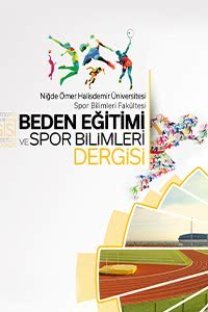Sporda hedef belirlemenin penaltı atışları üzerine etkisinin araştırılması
Bu çalışmanın amacı, ilköğretim altıncı, yedinci, sekizinci sınıflara devam eden ve okul futbol takımında oynayan erkek öğrencilerin penaltı atışlarındaki isabet yüzdesinin, psikolojik beceri antrenmanlarından, hedef belirleme (goal setting) yöntemi ile artırılıp artırılamayacağının araştırılmasıdır. Araştırmaya ilköğretim okuluna devam eden ve okul futbol takımında oynayan 12 erkek (yaş ortalaması = 13.92) sporcudan oluşan deney grubu ve 12 erkek (yaş ortalaması = 14.08) sporcudan oluşan kontrol grubu olmak üzere toplam 24 erkek sporcu katılmışlardır. Her iki grupta bulunan sporculara ön test için 5’er adet penaltı attırılmıştır. Her oyuncunun penaltı isabeti puantaja 5 üzerinden ve ayrıca yüzde olarak yazılmıştır. Her iki gruba düzenli olarak futbol antrenmanları yaptırılmış ve futbol antrenmanlarının yanı sıra, deney grubuna üç hafta boyunca hedef belirleme çalışmaları uygulanmıştır. Bu süre içinde kontrol grubuna hedef belirleme ile ilgili herhangi bir çalışma yaptırılmamıştır. Verilerin değerlendirilmesinde grupların ön-test ve son-testleri arasındaki farkı belirlemek için t testi istatistiği (Wilcoxon eşleştirilmiş iki örnek testi) uygulanmıştır. Deney grubunun ön testi ile son testi arasında istatistiksel olarak anlamlı farklılık bulunmuştur (p
The effect of goal setting in sports on penalty kicks
The purpose of this study is to determine whether penalty hit percentage of 6th, 7th,8th grade secondary school male students who play at the school football team can be increased with one of psychological skill training methods, goal setting. A total of 24 sportsman participated in the study. The experimental group consisted of 12 male students (mean age=13,92) who attend to a secondary school and play at the school football team and the control group consisted of 12 sportsman with a mean age of 14,08. As a pre-test all the participants from both groups took 5 penalties. Each participant’s penalty kick was recorded both with 5 point scale and percentage scale. Both teams received football training regularly, but the experimental group was exposed to goal setting training for three weeks. Meanwhile the control group received no additional training related with goal setting. T-test analysis (Wilcoxon two-sample paired test) was used to determine the difference between pre and post test of the groups. The statistical findings of the pre and post test scores of the experimental group were meaningful (p<0,05). In this study, it was found that together with football training, goal setting training had a positive effect on penalty kicks and increased the penalty kick performance of participants significantly. To conclude, the findings suggest that not only physical but psychological factors as well are important in increasing the penalty kick performance of football players.
___
- 1. Atahan, A., Akalan, C. (2008). Zihinsel
- 2. Antrenman ve Yüksek Performans. Spormetre Beden Eğitimi ve Spor Bilimleri Dergisiğ, 6 (1), 39- 43.
- 3. Botwina, R., Krawczynski, M. (2003). “Application of visulation in training of young football players”, XI. European Congress of Sport Psychology.
- 4. Botterill, C.B. (1977). “Goal setting and performance on an endurance task.” University of Alberta, unpublished doctoral dissertation.
- 5. Burton, D. ve Naylor, S. (2002). The Jekyll/ Hyde nature of goals: Revisiting and updating goalsetting in sport. Advances in Sport Psychology. (Edt): Horn, T. S. (Second edition). Illinois: Human Kinetics Books. Sf. 459-496.
- 6. Gill, D. (1986). Psychological Dynamics of Sport. Illinois: Human Kinetics Books
- 7. Gould, D. (1993). Goal setting for pesk performance. In Willias, J. M. (Ed) Applied Sprot Psychology: Personal Growth to Peak Performance. pp 158-165.
- 8. Konter, E. (2003). Spor Psikolojisi Uygulamalarında Yanılgılar ve Gerçekler, Dokuz Eylül Yayınları, s. 7, 31, 32, 37, Ankara.
- 9. Koruç, Z. (1996). Sporda hedef belirleme ve hedef belirleme modelleri. Sporda Psiko-Sosyal Alanlar Seminer Kitabı. Ankara Üniversitesi, 7-8 Haziran, 63-79.
- 10. Locke, E. A., Latham, G. P. (1985). The application of goal setting to sports. Journal of Sport Psychology, 7, 205-222.
- 11. Locke, E. A. ve Latham, G. P. (1990). A Theory of Goal Setting and Task Performance. Englewood Cliffs, NJ: Prentice Hall.
- 12. Locke, E.A. ; Shaw, K.N.: Saari, L.M.; Latham, G..P. (1981). Goal Setting and Task Performance: 1969-1980. Psychological Bulletin, 90, 125-152.
- 13. Sosovec, L. G. (2004). “Internal visual imagery and its effect on penalty kicks in soccer”, Unpublished Doctoral Dissertation, South Dakota State University.
- 14. Toros, T. (2001). Elit ve Elit Olmayan Erkek Basketbolcularda Hedef Yönelimi Güdüsel (Motivasyonel) İklim Hedeflerin Özgünlük ve Güçlük Derecesinin Yaşam Doyumuna Etkisi. (Yayınlanmamış Yüksek Lisans Tezi). Mersin: Mersin Üniversitesi, Sağlık Bilimleri Enstitüsü.
- 15. Lerner, B. S. ve Locke, E. A. (1995). The effects of goal setting, self-eficacy, competition, and personal traits on the performance of an endurance task, Journal of Sport & Exersice Psychology, 17, 138-152.
- 16. Weinberg, R.S.: Gould, D. (1995). Foundation of Sport and Exercise Psychology. Champaign, IL: Human Kinetics.
- ISSN: 1307-6477
- Yayın Aralığı: Yılda 3 Sayı
- Başlangıç: 2007
- Yayıncı: Niğde Üniversitesi Beden Eğitimi ve Spor Yüksek Okulu
Sayıdaki Diğer Makaleler
Maksimal yüklenme yoğunluğunun elit Türk eskrimcilerin görsel reaksiyon zamanları üzerine etkisi
Ahmet DUVAN, Turhan TOROS, Ömer ŞENEL
Üniversite öğrencilerinin sosyalleşmesinde spora katılımın değerlendirilmesi
Sporda hedef belirlemenin penaltı atışları üzerine etkisinin araştırılması
Turhan TOROS, Mehmet BAYANSALDUZ, Ahmet DUVAN
Profesyonel ve amatör futbolcuların statü değişkeni açısından başarı motivasyonu farklılıkları
Elit master atletlerin vücut kompozisyonu ve fiziksel performanslarının cinsiyete göre incelenmesi
